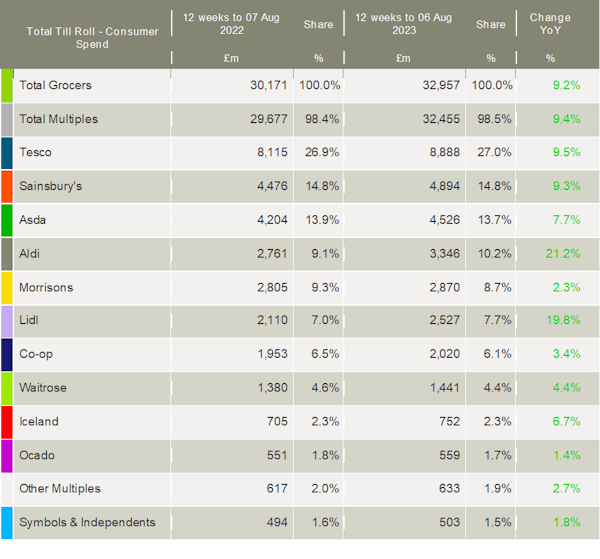Kantar has recorded the second sharpest monthly slowdown in grocery price inflation since it started monitoring the figure back in 2008, partly driven by the falling cost of some everyday food products.
The data shows inflation fell by 2.2 percentage points to 12.7% in the four weeks to 6 August, with take-home grocery sales growth slowing to 6.5% compared to 10.4% the previous month.
Whilst overall supermarket prices are still up yearly, consumers are starting to see falls on some staple goods compared with earlier in 2023. For example, the average cost of four pints of milk fell to £1.50 last month, down from £1.69 in March, and the price of a litre of sunflower oil is 22 pence less at £2.19.
Own-label goods remained popular in the latest period, with sales up by 9.7%, while branded products rose by 6.4%. Fraser McKevitt, head of retail and consumer insight at Kantar, commented: “Own-label sales continue to outpace branded, although the gap between the two is closing. Buying supermarket lines is just one of the ways people have been trying to save money at the tills, and we can see the impact on how much they are spending. The average increase in households’ weekly grocery shop is £5.13 compared with last year, well below the £11.27 extra they would have paid if consumers had bought exactly the same items as 12 months ago based on the current rate of inflation.”
While consumers grapple with price rises, Kantar highlighted that retailers beyond the supermarkets are also battling to maintain their position on the high street, with news of Wilko falling into administration signalling the extent of the challenges some businesses are facing. McKevitt said: “Wilko is a popular choice for many shoppers with 7.6 million households visiting its stores to buy groceries in the last year. Grocery items make up just under half of its sales, with homeware at 15%, DIY at 9% and garden products at 7%. Wilko’s rivals will be keeping a close eye on its fortunes in the coming days and weeks as they look to draw some of its shoppers through their doors.”
Meanwhile, the data confirms that last month’s unseasonable wet weather put the dampeners on sales of the usual summer lines. Volume sales of ice creams were down by 30%, while soft drinks sales were nearly a fifth lower than 12 months ago.
Kantar noted that instead of the usual summer fare, consumers had turned to more traditional winter warmers. The amount of soup bought was up by 16% year-on-year, while roasting joints grew by 5%.
Both Tesco and Sainsbury’s outperformed the market this month, with sales growth of 9.5% and 9.3% respectively over the 12 weeks to 6 August. Tesco’s market share rose from 26.9% to 27.0%, and Sainsbury’s held firm at 14.8%. Asda and Morrisons both lost market share after recording sales growth of 7.7% to 2.3% respectively.
Aldi was the fastest-growing grocery retailer for the fourth month in a row, with sales increasing by 21.2%. The discounter now has a market share of 10.2%, a rise of 1.1 percentage points year-on-year. Lidl’s sales climbed 19.8% and now holds 7.7% of the market.

NAM Implications:
- Morrisons losing share, possibly being pushed down to No.6 by Lidl in the near future?
- With the two discounters having a combined share of 17.9% and growing at 21.2% and 19.8% respectively, leaves suppliers with the question:
- “Do Discounters figure sufficiently high in our trade strategies?”
- (Also, where are Wilko shoppers most likely to transfer their allegiance?)




